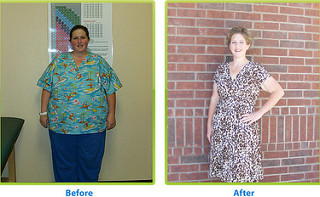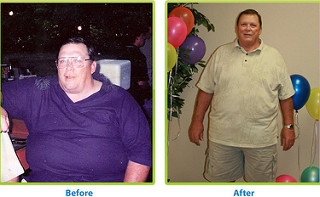The Truth Behind Your Weight Gain
 Food producers have been quick to respond to consumer demand for healthier food alternatives low in saturated fat. Many people have been successful in reducing their calorie intake and their weight as a result. However, we can’t be fooled; some products on store shelves have labels that are misleading and can actually cause weight gain, instead of weight loss.
Food producers have been quick to respond to consumer demand for healthier food alternatives low in saturated fat. Many people have been successful in reducing their calorie intake and their weight as a result. However, we can’t be fooled; some products on store shelves have labels that are misleading and can actually cause weight gain, instead of weight loss.
The large, bold print on the front of the product may be screaming ‘good for you’, but that is not always the case. The best way to avoid food scams is to get into the habit of reading the whole label. In addition to reading all the information, nutritionists and dieticians say you have to know your food terminology.
Food terms often sound like they are the answer to our weight woes, but here are a few examples that teach us the importance of understanding the terms:
Low fat: This can often mean that flavor enhancers like salt and additional sugars have been removed, but the product can still be high in calories because it still has sugar in it. Cereal bars, sauces, and dairy products are examples of this.
Whole foods: These are labeled as an alternative to eating chips or sugary snacks, yet they really can have hidden calories. Whole foods are an energy source so if you don’t use the energy it gets stored in your body as fat. Nuts are an example.
Good fats: These are good for your nervous system and brain function. A lot of people who want to lose weight turn to good fats… avocados and olive oil for instance. The problem is if you aren’t careful about the portion, good fats can be high in calories.
No Sugar Added: This does not necessarily mean sugar free. For example, food with fruit will have naturally occurring sugar.
Trans–fat-free: This term can be put on any product that is 0.5 grams of Trans-fat per serving so if you are consuming multiple servings you might be getting unwanted fat.
The Canadian Food Inspection Agency has strict rules and regulations about the advertising and labeling of food products. The agency’s guidelines specifically state that the labeling can’t create “false, deceptive or misleading” impressions; however, it can be difficult for food regulators to keep up with the barrage of new products on the market.
Nutritionists warn that marketing jargon can sound enticing and therefore consumers assume that the product is healthy. They use fortified and enriched as examples. What these two words usually mean is that the product is processed or lacking in whole wheat, which are normally higher in calories. They also point out that the word partial can be deceiving on packaging. For example, partially hydrogenated oil is code for Trans-fats.
When you are reading labels it is helpful to know what really qualifies as light, calorie free, lean etc. The following federal guidelines will help you the next time you make a trip to the grocery store.
Federal Definitions
Light: ½ the fat, 1/3 the calories or ½ the salt of the regular brand
Calorie free: 3 grams or less per 1 portion
Low fat: 40 calories or less per serving
Lean: Less than 10 grams of fat, 4.5 grams or less saturated fat, less than 95 milligrams cholesterol (one portion)
Extra Lean: No more than 5 grams of fat, less than 2 grams of saturated fat and less than 95 milligrams of cholesterol.
Portion or size control is also a big issue, particularly when it comes to snacks and drinks that could be high in saturated fat. For example, you can be fooled by a bag of chips that reads 150 calories per serving. Sounds good doesn’t it? Dig a little deeper and you might discover that one serving is just 5 or 6 chips. When you add up all the servings there is likely closer to 2,000 calories in that chip bag. Certain diet drinks will claim to be only 50 calories per serving so let’s say a serving is 8 ounces, but look a little closer and the bottle is in fact 20 ounces. That would be over 100 calories.
It isn’t always what is on the label that throws the consumer off. Sometimes weight gain can be attributed to what is not revealed. A good example of this is that many food companies round down numbers for carbohydrates and protein. This means you could be consuming more fat than you realize.
To get want you really want when you shop you have to be aware of what some foodies refer to as possible lies and loopholes. You can relate it to what your parents told you about contracts, “always look at the fine print before you sign on the dotted line.” In this case, always look at the label and calculate portion and size before you cash out.
-
All The Weight Loss Tips You Need To Know!
Like a lot of people, you have probably tried to get in shape ma
-
Weekly jab to lose weight and beat obesity
Can a Weekly Jab Beat Obesity?Health scientists have developed a
-
Why Eating Breakfast Every Morning Helps You Lose Weight
So many of the goals you set for yourself regarding we
-
Medifast Reviews - A Diet Plan With Real Benefits
If you are one of the many people who have tried in vain to find a wei
-
Happy weight versus Ideal weight...Weigh What You Want
You think you should ideally weigh what you did in college and yet you
-
6 Healthy Weight Loss Tips That You Should Know=
Healthy Weight Loss can be easy. It is very true that some people c
- DON'T MISS
- Dont Throw Your Money Away On Weight Loss Supplements
- Tips on How to Lose Weight Permanently
- Do You Want To Be Attractive?
- A Simple Way To Lose Weight in 2008I
- Lose 15 Pounds in Less Than Two Months: Four Diet Tips
- Weight Loss – How to Stop Emotional Eating
- Managing weight loss is often an easy activity
- Can You Lose Weight Fast And Still Remain Healthy?
- Diabetes What Are The Dangers Of Diabetes And How Does Diabetes Affect Weight Loss
- Weight Loss At Its Simple Best




